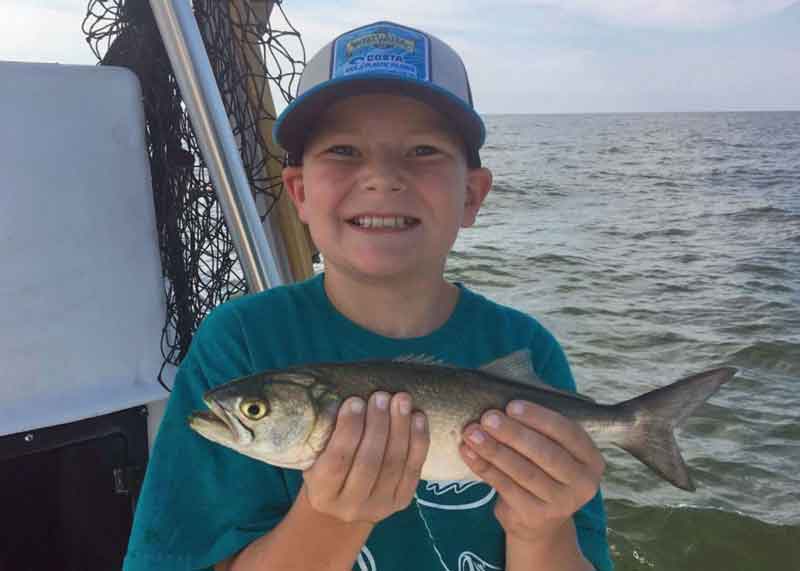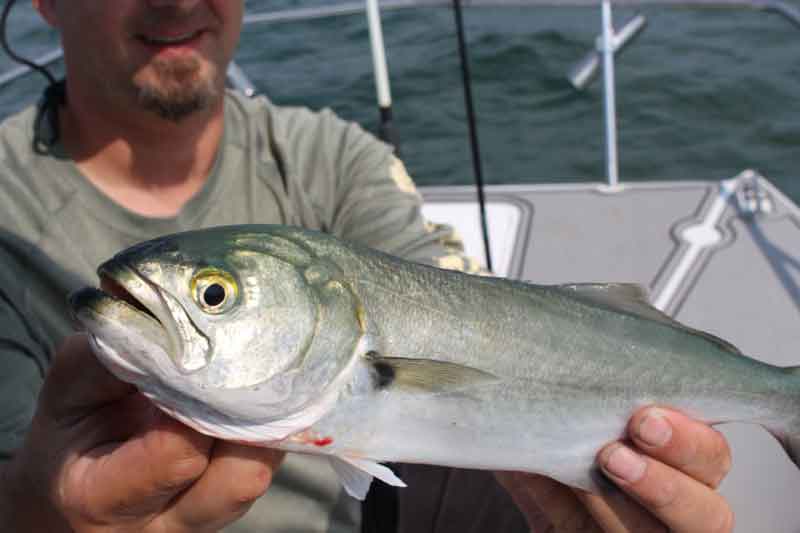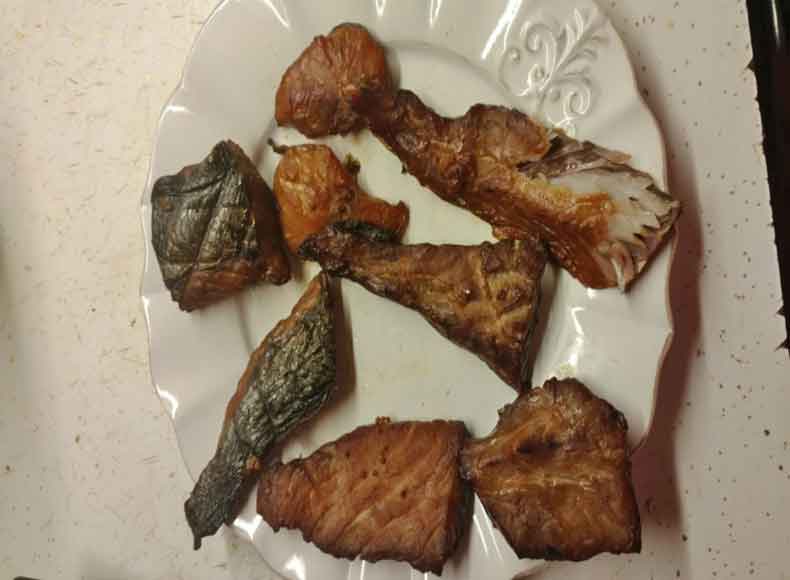What if someone told you there’s a fish that can be found across the Mid-Atlantic and that you can often catch while Chesapeake Bay fishing that attacks like an apex predator, fights above its weight, and launches out of the water several times during the fight? You’d probably think they were musing about Tarpon, right? Although Tarpon are sometimes encountered in the Chesapeake Bay they are extremely rare, while the fish we’re referring to is the very common, often overlooked, and frequently disparaged bluefish. But in truth, not only is this fish worth targeting it’s actually quite tasty in a variety of recipes.

Bluefish are found throughout the saltier areas of the Chesapeake and in many of its tributaries. Salinity is a key component to finding them, as bluefish are rarely found in the low salinities that species like striped bass can tolerate. Water temperature also plays a part. Typically, the bigger blues tend to stick with cooler water. Schools in the Bay tend to contain fish from six to 20 inches, with the occasional larger fish mixed in. Often you’ll find bigger blues mixed in with summer striper schools, usually demolishing a school of bait. You might not even know the blues are there until you start getting some half-plastics or half-spot returned to the boat, or worse, a chewed leader. Though there were huge blues marauding the Chesapeake in the 80s and 90s, these days you’re more likely to encounter them in our region’s coastal waters. If you want to find the really big fish, keep a close eye on fishing reports and be ready to leave at a moment’s notice – these schools might only be around a specific area for a couple of days.
Gearing Up for Bluefish Fishing
For tackle, setups commonly include rods from six-six to seven-foot and usually medium to medium-heavy, with braided line tied to a wire leader of 40-pound test or so. Many anglers clip a spoon to the end of the leader, since the blues will strike them readily and can’t chew through the metal. A great line of tooth-proof soft plastics to use for bluefish are Z-Man plastics, particularly their Diezel Minnowz and Grass Kickerz. Effective colors include Opening Night and Pearl/White, but you may find at times that reds and greens show up better in the often-discolored waters of the Chesapeake Bay. Either way, contrast often pays dividends. Matching a white paddletail with a red jighead, for example, may increase your catch rate. Blues also hit almost anything shiny and plugs will work as well, but remember that their teeth will really do a number on those pricey plugs.
If you want to try fishing for blues with bait instead, chumming is often effective and any bloody fish will work. Cutting bunker, spot, or mullet into strips or chunks will do just fine for the baits. You’ll want to opt for wire-leader snelled hooks, and circle hooks will help minimize deep hooking. You can also use heavier mono or fluoro leader, 50- to 80-pound test, as blues don’t seem to be too leader shy. However, keep an eye on it every time you bring the rigs back into the boat because a big bluefish will easily bust through a frayed leader.
Bluefish Fishing Tactics
One of the most effective methods of fishing for blues is trolling, particularly if you’re kayak fishing since you’re usually cruising at a typical trolling pace anyway. Cast those lures 50 to 75 feet back and start pedaling or paddling, and you should be in business. If you’re on a larger boat, remember that blues will often be mixed in with schools of Spanish mackerel and you’ll may be able to exclude one or the other based on trolling speed. As a general rule of thumb faster speeds (over six knots) will yield mostly Spanish mackerel, while slowing down yields mostly bluefish.
In any case, if you see birds working head for the spot. Schools of blues on the feed are commonly marked by gulls and terns dipping and diving on injured bait. When no birds are present, stick with trolling channel edges, shoals, and tributary river mouths.

Shoreline anglers should note that blues are frequently caught while surf fishing with cut bait off piers, beaches, and bridges throughout the region. The largest will be caught in the surf down at the beaches during the spring and fall runs, as the fish migrate north and south.
A note: if you’re on a kayak, a net is a must just to keep those toothy critters isolated from your vulnerable nether regions. A pair of fish grips or similar soft pliers will be necessary as well. Oh, they thrash around quite a bit too, so be warned. It’s all part of the fun of fishing for bluefish though, and once you’ve caught a few big ones you’ll be hooked – hopefully, only mentally.
How to Cook Bluefish
Once you’ve landed some blues you do want to take a few steps to ensure the best tasting fish possible. First, bleed the blues right away (a slice where the gills connect to the body is effective), and then ice them down immediately. They are an oily fish and the flesh is a lot softer than rockfish, so keeping it cold from the moment it’s landed is key. (I think most of the horror stories about how bad blues taste come from improper handling).
They fillet easily, and on larger blues the soft meat in the cheeks is worth harvesting. You may want to cut out the blood lines running down the middle of the fillets, as these do tend to have the strongest taste and scientists tell us that this is where contaminants can collect. Fish of 26 to 28 inches or larger taste stronger than smaller ones, and would probably be best saved for the smoker.
Baked Lemon Pepper Bluefish
Ingredients:
- About 1 pound of Bluefish fillets, scaled, skin on
- 1/2 Vidalia Onion
- 3-5 tbsp Olive Oil
- 1-2 tsp Lemon Pepper
- Salt and pepper
- A few drops of lemon juice (optional)
Preheat your oven to 350F, and trim your Bluefish fillets to fit into a baking dish. Lightly spread some olive oil in the dish, and toss the fillets in it a few times to coat the fish evenly. Slice your onion into long, thin strips, lay them along the fillets, and toss onion strips into the oil as well. Spread the lemon pepper, salt, and pepper across the fillets and onions. Bake for 15 to 20 minutes, depending on the size of the fillets, until the meat is flaky and easily cut with a fork.

Smoked Bluefish
Ingredients:
- About two pounds of bluefish fillets, skin on
- 1 quart water
- 1/2 cup whiskey (doesn’t have to be fancy)
- 1/4 cup Soy sauce
- 1/4 cup kosher salt
- 1/4 cup brown or white sugar
- 3-4 bay leaves
- 2 tbsp mustard seed
- 1 tbsp whole peppercorns
Combine all ingredients except the fish in a large bowl or container, and stir until the brine is well mixed. Add the fillets and refrigerate for a minimum of four hours, and a maximum of up to two days. The ideal amount of soak-time is depends on the thickness of your fillets, and personal preference on how strong you like the taste of the brine to linger within the fish. After brining, remove the fillets place them on metal racks above newspapers to catch the drippings. Dry until the fish feels tacky or sticky but not damp, and do not over-dry them. This tacky feeling is what’s called a “pellicle” and provides a sticky surface for the smoke to adhere to.
Once your pellicle has formed, it’s time to smoke. A simple charcoal smoker works well, but whatever you’re familiar with will work. Typically, hickory chunks are ideal as they give a nice strong smoky taste, but you can experiment and see what you prefer (cherry, mesquite, and apple are some other options). Pre-soak your wood chunks for at least 30 minutes, and keep the water bowl in the smoker full as fish fillets tend to dry out quickly when smoked. Heat your smoker up to about 200 to 225 degrees, and once the heat is steady, add your fillets. Smaller fillets will be done in about an hour at this temperature, whereas larger fillets will require an additional hour at a lower heat around 150 degrees. The finished product should have a deep brown color but not appear burnt, and the skin should be firm but a tad on the crispy side. You can eat the bluefish flaked with a fork then spread on bagels like smoked salmon, or you can serve them up with a little cream cheese and pickled onions on some crackers. Smoked bluefish can be safely kept refrigerated for up to a week, and it freezes well if you make a large batch.
By Patrick Spehnkouch